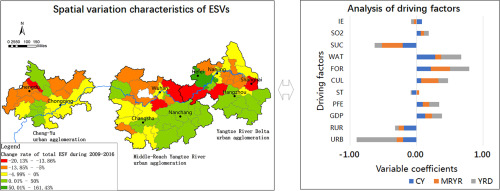当前位置:
X-MOL 学术
›
Sci. Total Environ.
›
论文详情
Our official English website, www.x-mol.net, welcomes your
feedback! (Note: you will need to create a separate account there.)
Spatial differences of ecosystem services and their driving factors: A comparation analysis among three urban agglomerations in China's Yangtze River Economic Belt.
Science of the Total Environment ( IF 8.2 ) Pub Date : 2020-04-06 , DOI: 10.1016/j.scitotenv.2020.138452 Qiaoling Luo 1 , Junfang Zhou 1 , Zhigang Li 1 , Bolin Yu 2
Science of the Total Environment ( IF 8.2 ) Pub Date : 2020-04-06 , DOI: 10.1016/j.scitotenv.2020.138452 Qiaoling Luo 1 , Junfang Zhou 1 , Zhigang Li 1 , Bolin Yu 2
Affiliation

|
Understanding the spatial distribution characteristics of ecosystem service value (ESV) and their underlying driving factors is critical for ecosystem service management. Using three national-level urban agglomerations in the Yangtze River Economic Belt, Cheng-Yu (CY), Middle-Reach Yangtze River (MRYR), and Yangtze River Delta (YRD), as a case study, this paper quantifies the ESVs and the spatial distribution characteristics, analyzes the driving factors of ESVs using the stochastic impacts by regression on population, affluence, and technology model (STIRPAT). The results specify that: (1) Over the study period 2009-2016, the total ESV of the three urban agglomerations decreases by 5498.70 million USD. The regulating, supporting, and cultural service decrease by 4607.60, 2648.01, and 1182.25 million USD, respectively, while the provisioning service increases by 2795.15 million USD. (2) ESV in MRYR undergoes the largest reduction of 4269.70 million USD, followed by CY and YRD with 1015.66 and 213.35 million USD from 2009 to 2016. (3) In 2016, among the 70 cities at the prefecture level or above, the cities with high total ESV, per unit area ESV, and per capita EVS are mainly distributed to the areas of the south Yangtze River of MRYR and YRD, MRYR, and MRYR and YRD, respectively. (4) In general, land use and cover, population are the main factors affecting ESVs, followed by economic, social and political factors. Among the three urban agglomerations, population, land use and cover basically have the equally important impacts on ESV in CY; land use and cover, especially the proportion of urban construction land has the greatest impact on ESV in MRYR; population, especially the urbanization rate has the greatest impact in YRD. The comparative analysis of the driving factors of ESVs in different regions is helpful to propose differentiated ecological protection policies and promote the increase of ESV accordingly.
更新日期:2020-04-06











































 京公网安备 11010802027423号
京公网安备 11010802027423号